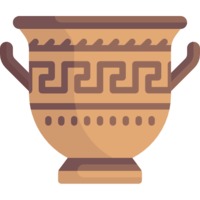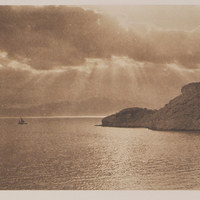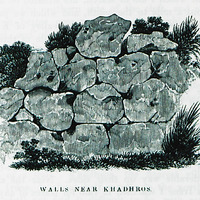Κάντανος
Αντικείμενο
Τίτλος Σημείου Ενδιαφέροντος
el
Κάντανος
en
Kantanos
Περιγραφή / Απόσπασμα
150-154
en
From the summit we have a fine view of the valley of Kantanos : we are three or four miles from the sea, to which the valley leads in a southerly direction : the little villages designated by the common term Kantanos are near its north-eastern extremity : the hills on both sides of the valley are well covered with olive-trees for a considerable way up their sides.
Σύγχρονη περιγραφή
el
Η Κάντανος απέχει 52 χιλιόμετρα από τα Χανιά και είναι κτισμένη στη θέση της ομώνυμης αρχαίας πόλης που ιδρύθηκε το 1049 π.Χ. Το όνομα της προέρχεται είτε από το αρχαίο «Καντανία», που σημαίνει «πόλη της νίκης», είτε από τη λέξη «Κάντορες», που σημαίνει οι κρατούντες. Στα πρωτοχριστιανικά χρόνια ήταν έδρα Επισκοπής της Κρήτης, ενώ η αρχαία Κάντανος εξακολούθησε να υπάρχει και κατά τη Βυζαντινή περίοδο. Από την Βυζαντινή περίοδο έχουν σωθεί πολλές αξιόλογες εκκλησίες, όπως η Αγία Κυριακή, ο Μιχαήλ Αρχάγγελος και η Αγία Άννα, με μία σπάνια αγιογραφία της Αγίας Άννας να θηλάζει την Παναγία. Στην Τουρκοκρατία ήταν κέντρο γενιτσάρων και έγιναν πολλές μάχες στην περιοχή για να εκδιωχτούν. Τελικά, η αρχαία Κάντανος καταστράφηκε από τους Άραβες και δεν ανοικοδομήθηκε ποτέ ξανά.
Στα προπολεμικά χρόνια, στην αρχαία Κάντανο, ανασκάφηκε ένα μεγάλο οικοδόμημα που διαθέτει δάπεδο στρωμένο με μωσαϊκά, με γραμμικά σχήματα, κύκλους και ρόμβους και κατασκευάστηκε κατά τη ρωμαϊκή εποχή. Επίσης, εδώ βρέθηκε και η βάση ενός αγάλματος, που σύμφωνα με τους αρχαιολόγους ήταν αφιερωμένο στο Ρωμαίο αυτοκράτορα Σεπτίμιο Σεβήρο.
Η Κάντανος στιγματίστηκε από ένα μαρτυρικό γεγονός, που συνέβη κατά τη διάρκεια της Ναζιστικής Κατοχής, όταν οι κατακτητές εκτέλεσαν τους κατοίκους και έκαψαν το χωριό, ως αντίποινα για το θάνατο 25 στρατιωτών τους. Λίγο αργότερα, τοποθέτησαν τρεις επιγραφές, στις οποίες μεταξύ άλλων ανέφεραν: «Εδώ υπήρχε η Κάντανος, κατεστράφη προς εξιλασμόν της δολοφονίας 25 Γερμανών Στρατιωτικών» και «…κατεστράφη την 3/6/41 η Κάντανος εκ θεμελίων διά να μην επανοικοδομηθεί πλέον ΠOTE».
Στα προπολεμικά χρόνια, στην αρχαία Κάντανο, ανασκάφηκε ένα μεγάλο οικοδόμημα που διαθέτει δάπεδο στρωμένο με μωσαϊκά, με γραμμικά σχήματα, κύκλους και ρόμβους και κατασκευάστηκε κατά τη ρωμαϊκή εποχή. Επίσης, εδώ βρέθηκε και η βάση ενός αγάλματος, που σύμφωνα με τους αρχαιολόγους ήταν αφιερωμένο στο Ρωμαίο αυτοκράτορα Σεπτίμιο Σεβήρο.
Η Κάντανος στιγματίστηκε από ένα μαρτυρικό γεγονός, που συνέβη κατά τη διάρκεια της Ναζιστικής Κατοχής, όταν οι κατακτητές εκτέλεσαν τους κατοίκους και έκαψαν το χωριό, ως αντίποινα για το θάνατο 25 στρατιωτών τους. Λίγο αργότερα, τοποθέτησαν τρεις επιγραφές, στις οποίες μεταξύ άλλων ανέφεραν: «Εδώ υπήρχε η Κάντανος, κατεστράφη προς εξιλασμόν της δολοφονίας 25 Γερμανών Στρατιωτικών» και «…κατεστράφη την 3/6/41 η Κάντανος εκ θεμελίων διά να μην επανοικοδομηθεί πλέον ΠOTE».
en
Kantanos is 52 kilometers from Hania and is built at the position of the ancient city with the same name that was founded in 1049 BC. Its name comes either from the ancient “Kantania”, which means city of victory, or from the word “Kantores”, which means powerful men. During the early Christian times, it used to be a Diocese of Crete, while ancient Kantanos still existed in Byzantine times. Since the Byzantine period, many remarkable churches have been preserved, such as Agia Kyriaki, Michael Archangel and Agia Anna, with a rare hagiography depicting Agia Anna nursing the Virgin Mary. During the Ottoman rule, this was a center of the Janissaries and many fights were fought in the area to drive them out. Finally, ancient Kantanos was destroyed by the Arabs and was never reconstructed again.
In the antebellum years, in ancient Kantanos, a big building was excavated, which had a floor paved with mosaics, with linear shapes, circles and rhombuses and was built in Roman times. Also, the base of a statue was found there, which, according to archaeologists, was dedicated to the Roman emperor Septimius Severus.
Kantanos was marked by a tragic event, which happened during Nazi occupation, when the conquerors executed the residents of the village and burnt it down, as retaliation for the death of 25 German soldiers. Sometime later, they put three signs to which, among other things, they mentioned: “Kantanos used to be here, which was destroyed for the retaliation of the murder of 25 German soldiers’” and “...Kantanos was destroyed on 3/6/41, up to its foundations, so that it may NEVER be rebuilt again”.
In the antebellum years, in ancient Kantanos, a big building was excavated, which had a floor paved with mosaics, with linear shapes, circles and rhombuses and was built in Roman times. Also, the base of a statue was found there, which, according to archaeologists, was dedicated to the Roman emperor Septimius Severus.
Kantanos was marked by a tragic event, which happened during Nazi occupation, when the conquerors executed the residents of the village and burnt it down, as retaliation for the death of 25 German soldiers. Sometime later, they put three signs to which, among other things, they mentioned: “Kantanos used to be here, which was destroyed for the retaliation of the murder of 25 German soldiers’” and “...Kantanos was destroyed on 3/6/41, up to its foundations, so that it may NEVER be rebuilt again”.





